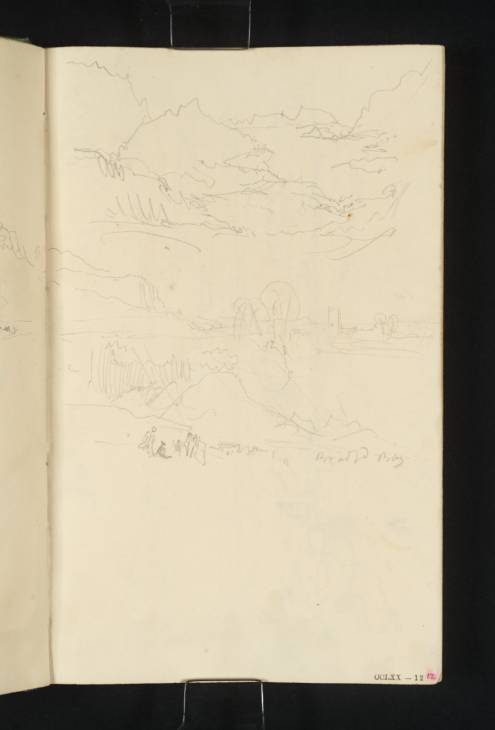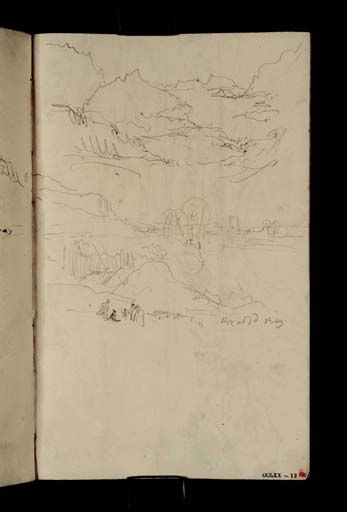Joseph Mallord William Turner Loch Scavaig from the North; Broadford Bay, Skye; and Cambuskenneth Abbey 1831
Image 1 of 2
Joseph Mallord William Turner,
Loch Scavaig from the North; Broadford Bay, Skye; and Cambuskenneth Abbey
1831
Joseph Mallord William Turner 1775–1851
Folio 12 Recto:
Loch Scavaig from the North; Broadford Bay, Skye; and Cambuskenneth Abbey 1831
D26458
Turner Bequest CCLXX 12
Turner Bequest CCLXX 12
Pencil on white wove paper, 201 x 125 mm
Inscribed in pencil by Turner ‘Broadfd Bay’ centre right
Inscribed in red ink by John Ruskin ‘12’ bottom right
Stamped in black ‘CCLXX – 12’ bottom right
Inscribed in pencil by Turner ‘Broadfd Bay’ centre right
Inscribed in red ink by John Ruskin ‘12’ bottom right
Stamped in black ‘CCLXX – 12’ bottom right
Accepted by the nation as part of the Turner Bequest 1856
References
1909
A.J. Finberg, A Complete Inventory of the Drawings of the Turner Bequest, London 1909, vol.II, p.868, CCLXX 12, as ‘Mountains., &c.’.
1936
Henry J. Crawford, Turner’s Sketches and Drawings of Stirling and Neighbourhood With Some Notes on the Artist’s Scottish Tours also A Note on John Ruskin and Stirling, Stirling 1936, p.22.
David Wallace-Hadrill and Janet Carolan identified the sketch at the top of the page as a view of Loch Scavaig, a sea loch at Skye, seen from the shoulder of Sgurr na Stri to the north. The subject is identified by the shape of the island in the background which is Eigg. Part of the mountain of Sgurr na Stri fills in the foreground at the left, and at the right is the eastern shoulder of Gars-bheinn. Turner made this sketch during a visit to Loch Coruisk where he climbed Sgurr na Stri, from where he made views of the loch (folios 38 verso and 39; D26511, D26512) and of the Isle of Rum (folios 34; D26502). See folio 38 (D26510) for further sketches of Loch Scavaig.
The third sketch was also made on the Isle of Skye, though on a later occasion when Turner visited Broadford Bay. The sketch, inscribed ‘Broadfd Bay’,1 was probably made from the bay itself and looks west towards Beinn na Caillich, one of the Red Cuillins, with a few houses in the middle distance representing Corry, the old part of the town. Turner shows dark clouds gathering to the south of the hill and heavy sheets of rain falling across the landscape. In the foreground are a group of four or five figures, one of whom sits on the ground while the others stand around. These may be fellow tourists. The figure at the left looks well dressed in a long coat and is perhaps holding his hat in his right hand.
Broadford, though small, is Skye’s second largest settlement after Portree. David Wallace-Hadrill and Janet Carolan have suggested that it was ‘for Turner a central point from which to travel east and west on good roads.’2 However, the sketch that they argue may prove he went west a short distance was in fact mis-identified,3 meaning that he is likely to have gone straight from Broadford to Kyleakin (see folio 75: D26584). There are further sketches of Broadford on folios 69 verso, 70 and 85 verso–86 (D26573, D26574, D26604–D26605).
The sketch at the middle of this page, continuing on folio 11 verso (D26457) shows Cambuskenneth Abbey in Stirling as seen from across the River Forth to the south-west of Abbey Craig.
Thomas Ardill
March 2010
David Wallace–Hadrill and Janet Carolan, ‘Turner on the Isle of Skye 1831’, [circa 1991], Tate catalogue files, [folio 21].
David Wallace-Hadrill and Janet Carolan suggested that the inscription ‘Clach’ on folio 70 verso (D26575) could stand for the village of Clachan on the island of Raasay, as they had identified the sketch beneath as Skye. (Ibid. p.24). That sketch, however, is now known to be of Finlaggan on Islay, meaning that there is no strong evidence that Turner travelled west along the coast from Broadford.
How to cite
Thomas Ardill, ‘Loch Scavaig from the North; Broadford Bay, Skye; and Cambuskenneth Abbey 1831 by Joseph Mallord William Turner’, catalogue entry, March 2010, in David Blayney Brown (ed.), J.M.W. Turner: Sketchbooks, Drawings and Watercolours, Tate Research Publication, December 2012, https://www


